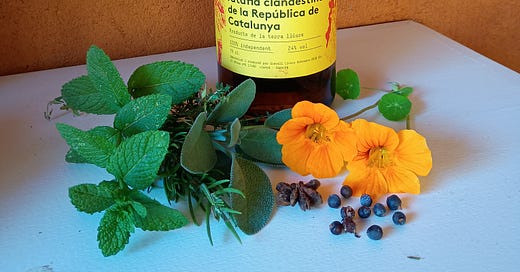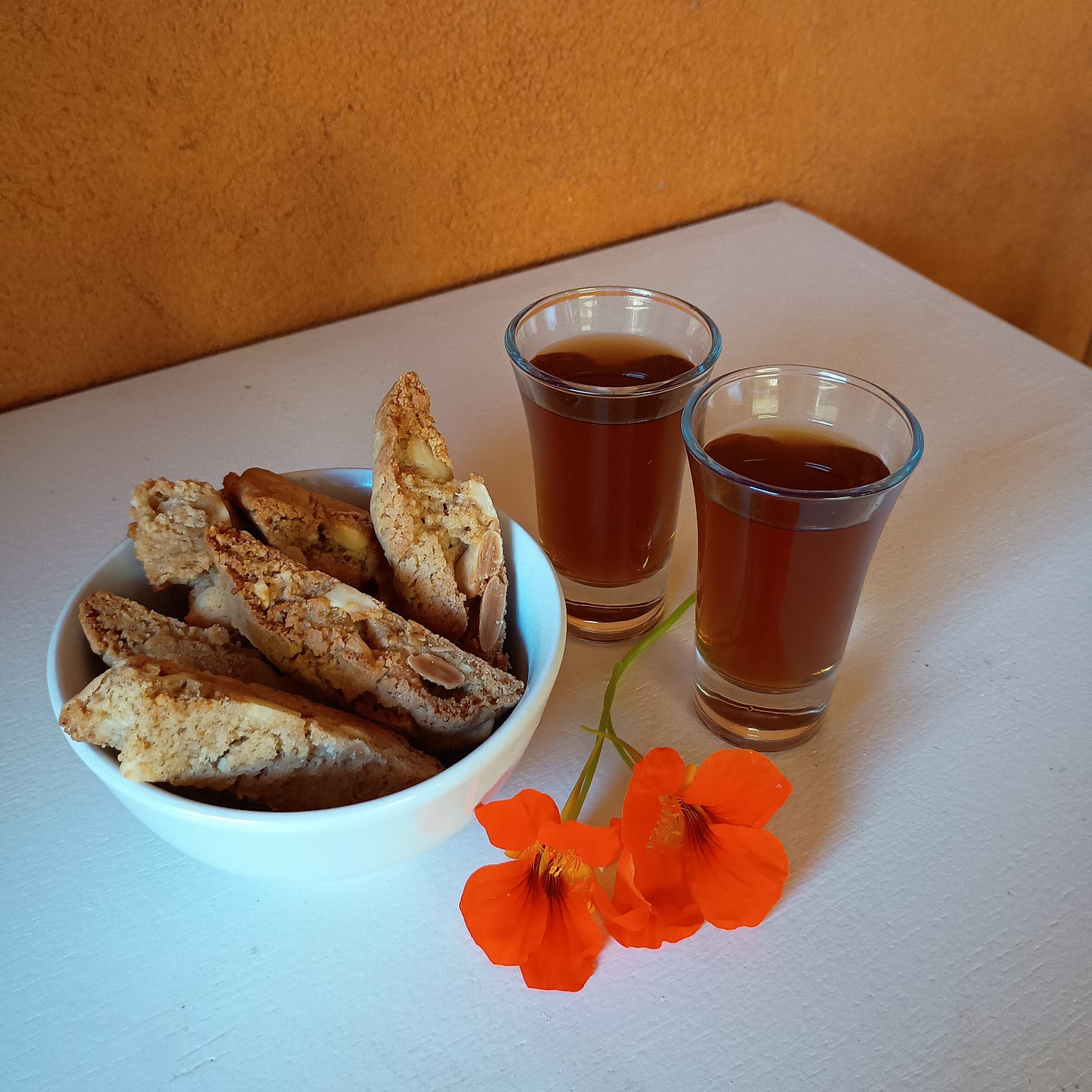Ratafia and Carquinyolis: a classic Catalan combination
An addendum to my recent Sant Joan newsletter...
What an oversight!
It’s been drawn to my attention that in my recent post on St John’s Eve (23 June) I failed to mention one of the most deep-rooted traditions in rural Catalonia: the preparation of ratafia using green walnuts harvested on this very date, along with a whole array of herbs and spices. The result is a unique liqueur that distills all the flavours and aromas of the Catalan countryside.
The name ratafia stems from the Latin rata fiat which translates literally as “let it be done”. In medieval times it came to be used to refer to the sweet liqueur raised as a toast to ratify a deal or formal ceremony such as a marriage.
Ratafia is made from a base spirit and a blend of local herbs and spices, but the crucial ingredient that sets Catalan ratafia apart from any other is the use of green walnuts, which add a uniquely bitter tang. It was originally made by monks for medicinal purposes, then local people acquired the monks’ recipes and started making their own versions. The first registered formula in Catalonia dates back to 1842 in the town of Santa Coloma de Farners (not far from Girona).
At that time it was mainly made by women, one of the key reasons being that it was alleged to soothe period pains. Or maybe that was just an excuse to imbibe! The fact is that green walnuts contain polyphenols, flavonoids and tannins with antioxidant, anti-inflammatory and antimicrobial properties, so it may be that ratafia truly does have medicinal benefits.
There are as many recipes for ratafia as there are farmhouses in Catalonia. In other words, a lot. Recipes are fiercely guarded and passed down from generation to generation, becoming part of the family heritage. For this reason there is no standard recipe, but certain ingredients are common to all of them:
Spirit: some form of neutral spirit. In Catalonia they use aguardiente or alcohol vínic, a distillation of the by-products of grape fermentation. You can use vodka or any other flavourless spirit, ideally around 40º proof. You could also use any anis-based liqueur, in which case you will need to add much less sugar syrup at the end of the process.
Spices
The most frequently used spices are nutmeg, cloves, star anise, cumin, juniper berries, cardamom and cinnamon. The key is to blend them judiciously so no single flavour stands out above the others. If your spirit base of choice is anis, leave the star anise out.
Green walnuts
This is the ingredient that really distinguishes a Catalan ratafia from any other, and ideally they should be collected on 23 June, the eve of Sant Joan. Some people only use the outer peel, which lends its colour to the clear spirit, though most use the whole walnut cut into halves or quarters which adds a slightly bitter or astringent flavour.
Herbs
This is where each individual’s preference (and creativity) comes into play. You can use all kinds of different herbs: the full gamut of mints, citrus-flavoured ones, and herbs with digestive properties, as ratafia is usually taken as a digestif. Freshly-picked, dried, whatever you have to hand.
You will also need:
• A very large wide-necked glass preserving jar (e.g. Kilner or Mason) with a capacity double that of the amount of spirit you intend to use.
• Gloves for handling the walnuts as they stain the skin really badly.
• Knife, scissors, funnel.
The following ingredient list, provided by a local farmer, is for guidance only:
1 litre spirit or your choice
3-4 green walnuts
1-2 cinnamon sticks
A few gratings of nutmeg
1 star anise
2 cardamom seeds
5-6 juniper berries
½ teaspoon cumin seeds
Peel of 1 lemon
Walnut-sized piece of ginger root, grated
2 cloves
Any mixture of thyme, rosemary, sage, lemon balm, mint, oregano, sweet marjoram, fennel, bay, chamomile, lavender or any other herbs you fancy: if fresh, a small bunch of each; if dry, a teaspoonful.
Method
Go to your nearest walnut tree and pluck four or five green walnuts. Pour your chosen alcohol into the glass jar. Cut the walnuts in half or quarters (use gloves, otherwise your hands will look as if you have been at a henna convention) and pop them into the alcohol to start macerating. Chop all the herbs and spices roughly, add to the jar and give it a good stir.
Cover with a muslin or cotton cloth, put the lid on, and leave outside for exactly 40 days in what is known as sol i serena. This means putting it on a balcony, terrace, window sill or in the garden so the mixture is ‘cooked’ in the sun during the day and cooled at night. Give the jar a good shake or stir every couple of days.
After 40 days, pour the contents through a funnel lined with a muslin cloth, throw away all the solids and there you have your artisan ratafia! However, at this point it will have a very high alcohol level which needs to be reduced; it will also be quite bitter and need sweetening unless your base spirit was anis.
Make a simple sugar syrup by boiling 500g sugar with 500ml water water until the sugar has completely dissolved and you have a syrupy consistency. Add a cupful to your ratafia, return it to the macerating jar, and leave for a couple of days before tasting. Continue this process until you reach your preferred level of sweetness. Now leave the ratafia to age for a further two months.
Decant into smaller bottles (again using a funnel and muslin cloth, as it will have become slightly cloudy) and keep in the fridge.
Chill well and pair it with cured cheeses, chocolate or any kind of dessert. Drizzle over ice cream. Have a glass with your coffee. Or in your coffee. Dip biscuits into it (especially carquinyolis, the Catalan version of biscotti).
But let’s be completely honest here, you’re not going to go to all this trouble are you? Unless you happen to have easy access to a walnut tree and the patience of a saint. So I embarked on an internet search for somewhere that sells genuine Catalan ratafia outside Catalonia, and guess what? I couldn’t find one. Not even Berry Bros. Amazing.
I might be on to something here.
But if you’re here in Catalonia, some of the most popular branded ratafias to try are Bosch, Russet, Rufaca and L’Hòstia Hardcore (strong!).
For more information about all things ratafia, visit the excellent site www.ratafies.cat, though it’s currently only available in Spanish or Catalan.
A little something I prepared earlier…
Of course, now I’ve mentioned carquinyolis, I should really give you the recipe, which you’ll be glad to hear is a great deal more straightforward than the one for ratafia and can be whipped up in under an hour.
Carquinyolis have been eaten in Catalonia for centuries, probably since medieval times, though the first written recipe dates back to the late nineteenth century. They are crunchy, oval, twice-baked biscotti, usually made with raw almonds though you can also use hazelnuts or pistachios.
Here in Catalonia they are generally served after a meal with coffee or with cava, muscatel or ratafia for dipping. They are also often paired with crema catalana (the ubiquitous Catalan crème brûlée) and are delicious crumbled and sprinkled on vanilla ice cream with a dash of ratafia.
Ingredients
50ml ratafia or anis liqueur
300g flour
200g raw unskinned almonds
200g sugar
2 eggs
Finely grated zest of 1 lemon
1 heaped teaspoon cinnamon powder
10g baking powder
100g butter, slightly softened*
Twenty minutes before you start, put the almonds in the ratafia or anis to soak and pre-heat the oven to 190ºC (170ºC fan).
Drain the almonds and discard the liqueur (I like to do this by drinking it). Put the almonds and all the other ingredients into the bowl of a stand mixer. Beat on a low speed until the mixture forms a clump. You can also mix everything together with your hands, though it will take a bit longer.
Scatter a little flour on the worktop. Divide the mixture into four and roll each section into a log with a diameter of about 4 cm. Place the logs on a baking tray, leaving space between them to spread. Bake for 10-12 minutes and remove from the oven. Allow to cool slightly, then use a very sharp knife to cut the logs into diagonal slices about 1.5 cm thick. Put them back on the baking tray with the cut sides up, as close as you like this time, and bake for another 10 minutes or until golden brown.
*Note that butter is not traditionally used in carquinyolis, nor is oil for that matter, but it gives a much nicer mouthfeel. This version is ideal for people with dentures, who usually avoid carquinyolis like the plague.





